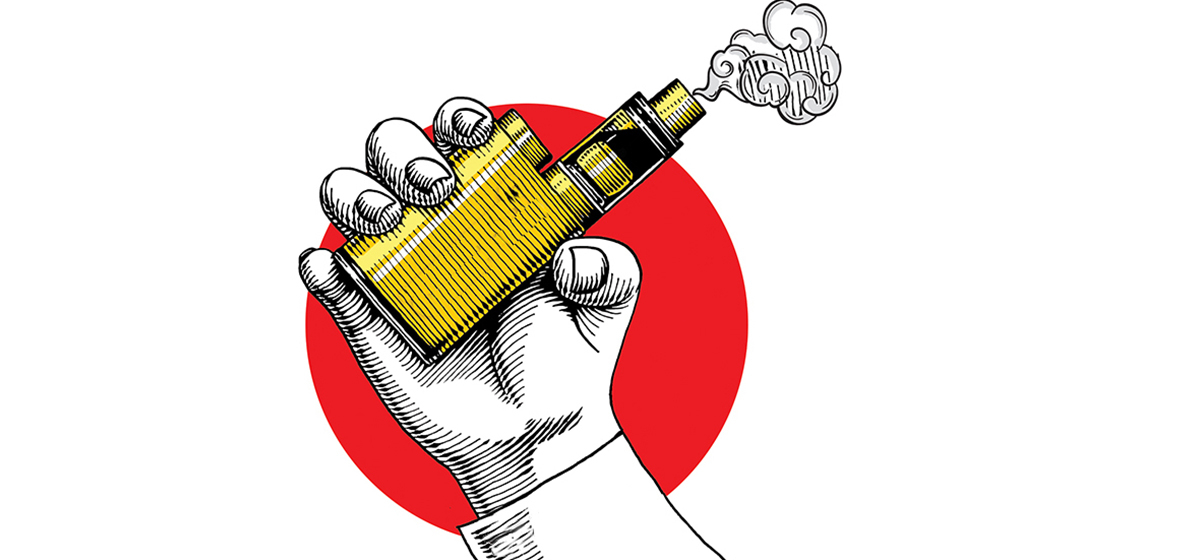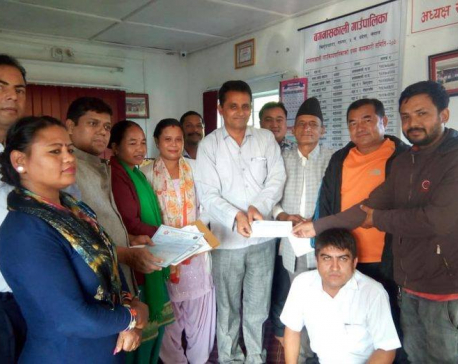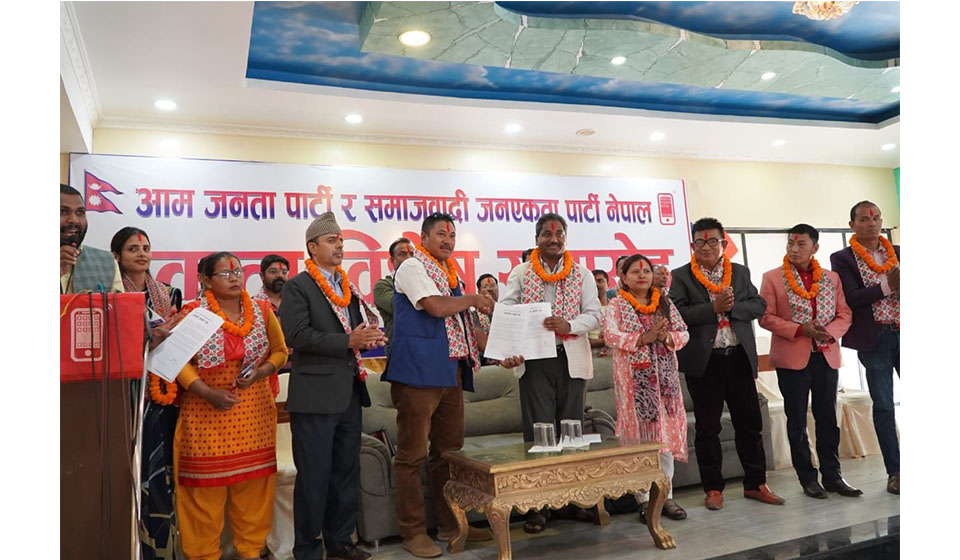
OR
Youths struggle with vape addiction: a drain on finances and health
Published On: December 28, 2023 09:38 PM NPT By: Pabitra Sunar

KATHMANDU, Dec 28: Ayush Sharma (name changed), a young man from Chabahil, Kathmandu, first tried vaping (e-cigarettes) two years ago with a friend and quickly developed an addiction. Now a regular user, he admitted, "In the beginning, I was drawn in for the taste, and now it's a habit."
Similarly, 23-year-old Sabin Thapa (name changed) from Baneshwar, Kathmandu, initially turned to vaping to quit smoking while in college but ended up getting addicted to both cigarettes and vape. Despite their desire to quit, both Sharma and Thapa find it challenging to break free from their vape addiction. Thapa shared, "I know that vape is just as harmful as cigarettes, but I couldn't quit even if I wanted to."
The prevalence of youth using vape is high, extending beyond major cities like Kathmandu, Pokhara, Biratnagar, Chitwan, and Butwal. Vape products are available through wholesale, retail, and online channels in these urban centers.
The popularity of vape among young people is on the rise due to its accessibility and appealing flavors. An online seller from Kathmandu revealed, "Selling online brings in a profit of Rs 150,000." According to traders, online orders surpass direct in-store purchases, with one stating that they have been trading vape online for five years. Another trader in Lalitpur’s Pulchowk noted an increasing demand for vape. In the fiscal year 2021/22, Nepal imported vape worth over Rs 11 million, with 426,372 units imported in 2022/23, as reported by the Department of Customs.
New vape flavors flooded the market in the past year, and disposable vapes are gaining popularity. A Biratnagar seller highlighted the growing attraction of youth to disposable vape due to the diverse taste options. The retail price for the new flavored vape is Rs 2,000, resulting in a profit of Rs 600. Rechargeable devices that require coil replacement are pricier than disposable ones, and reusable devices are available at varying prices. Sellers note that vape in Nepal is imported from China and the USA, with prices varying based on device and quality.
Traders mention various reasons for using vape, including taste preferences, smoking cessation efforts, and the belief that it is less harmful than cigarettes. Dr Bidesh Bista, a respiratory and thoracic specialist at Civil Hospital, highlighted that some people use vape to appear fashionable among their peers. He added, "It is also found that some people use vape in front of their friends and later smoke cigarettes after reaching home."
According to vape users, costs are determined by usage frequency, with monthly expenses ranging from Rs 3,000 to Rs 10,000. However, users note that vape is significantly more expensive than cigarettes, with one vendor in Pulchowk stating, "If one uses it more than once or twice a day, it will cost more. The cost of vape is more expensive than the cost of cigarettes."
What is Vape?
Vape, short for electronic cigarette or e-cigarette, is an alternative to traditional cigarettes where vapor is inhaled by inserting a refill into an electronic device. The concept originated in 2004 when Hanlik, a Chinese pharmacist, began producing vape as a modern cigarette. The popularity of vape quickly spread, leading to its production in various countries worldwide.
Both nicotine-containing and nicotine-free vapes are available in the market, and despite its dissimilarity in appearance to traditional cigarettes, it functions similarly and is considered addictive. This has led to its colloquial name, e-cigarette. Users often believe that vaping poses less harm than smoking traditional cigarettes.
The introduction of vape in Nepal dates back to 2014, marking nearly a decade since its inception in the country. Since 2017, vape products have been widely available in the market. While some countries, including Australia and India, have imposed restrictions on the sale and distribution of vape, Nepal currently lacks legal obstacles for its use.
Vape is as injurious as cigarettes: Doctors
Despite claims that vaping is less harmful and nicotine-free, doctors assert that it poses serious health risks. Dr Bidesh Bista emphasizes that vaping contains various harmful chemicals, including nicotine, with levels comparable to traditional cigarettes. While the amount of carbon monoxide in vape is slightly lower than that in cigarettes, both immediate and long-term health effects on users are considerable.
Dr Bista notes that asthma patients who use vape experience immediate breathing difficulties, leading them to seek hospital treatment. Long-term use of vape increases the risk of developing asthma and lung cancer due to the abundance of harmful chemicals. According to Dr Suraj Gupta, a chest specialist at Norvic Hospital, individuals using both vape and cigarettes often seek treatment for lung problems. Dismissing claims that vape helps quit smoking, Dr Gupta asserts that it fosters addiction.
Even the so-called nicotine-free vapes may contain other harmful chemicals. Dr Gupta observes that vape users are predominantly young individuals, a concerning trend reflected in patients seeking treatment. Vaping-related issues include difficulty in breathing, coughing, and chest pain.
Dr Gupta and Dr Bista advocate the justifiable banning of vaping, considering its detrimental impact on the health and finances of the youth. Dr Gupta suggests that banning vape, perceived as a fashion statement initially, is a necessary step. As the number of individuals becoming addicted to vape rises, both doctors recommend prohibiting its sale and use to safeguard public health.
You May Like This

To retain youths in villages, rural municipality initiates loans against educational certificates
PALPA, July 10: Bagnaskali rural municipality of Palpa has started to provide loans to promote self employment in agriculture and... Read More...

Kaura Aura Grips Syangja Youths
Women clad in traditional Magar dress that comprises gunyo choli, patuka, teki, hamle, yellow potey, and men with damfus (a... Read More...

Battling illiteracy: Youths launch tuition classes for community's children
SARLAHI, Jan 9: Eight-year-old Deepak Majhi has never been to school. Just like other children of the Mushahar community in Gadhetole... Read More...




Just In
- Sunkoshi-Marin Diversion Project’s tunnel construction nears completion, breakthrough scheduled for May 8
- Govt tightens security arrangement for Third Investment Summit 2024
- Pesticide residue found in vegetables in Nepalgunj
- Aam Janata Party and Samajwadi Jana Ekata Party merge
- 1,600 participants confirmed for Nepal Investment Summit
- Ilam-2 by-elections held peacefully, vote count likely to start tonight
- NEA schedules five-day power cut across Kathmandu Valley for underground cable installation
- Hundreds of passengers including foreign tourists in distress as poor visibility halts flights to and from PRIA







-1200x560-wm_20240427144118.jpg)





Leave A Comment